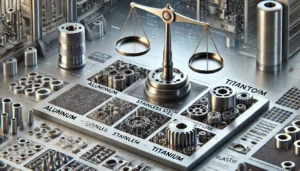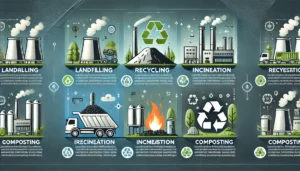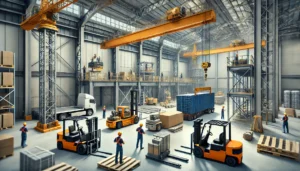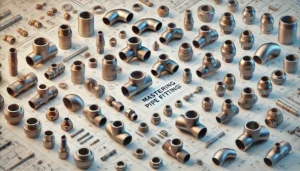One of the major concerns for Industrial piping systems is the use of multiple materials together that are used to transport different fluids. Galvanic occurrence corrosion in a piping system arises during the combination of two distinct metals, while electrolytes like water or moisture is present and incorporated together. If left unaddressed over long time periods, galvanic corrosion weakens various components within the piping systems, eventually causing leakage, structural failure, damage to the system and in case the component needs repairing, it becomes tedious and an expensive task.
On this blog, we will discuss how galvanic corrosion takes place in industrial piping systems and what current day solutions can be used to prevent or further manage the issue.
What is Galvanic Corrosion?
Galvanic Corrosion is an electrochemical phenomenon that occurs when two different metals are submerged in an electrolyte and one of the metals i.e. anode deteriorates faster, while the other metal also known as cathode stands unaffected. This leads to the usage of electric current that travels between those two metals due to having different electrode potentials.
Take for instance the use of a composite piping system that includes carbon steel along with high chromium stainless steel, during the use of that system, the carbon steel will surely corrode while the chrome stainless steel will exhibit resistance.
Common Scenarios of Galvanic Corrosion in Piping Systems
Due to the complexity of the arrangement, it is not surprising that galvanic corrosion is a concern for many piping systems. Some examples are:
Mixed-Metal Systems: When pipelines combine materials such as copper steel or steel and aluminum.
Flanges and Bolts: Dissimilar metals used in flange joints or fasteners can create a galvanic cell.
Marine Environments: Saltwater acts as an electrolyte and galvanic corrosion will take place on Offshore and shipboard pipelines.
Heat Exchangers: Corrosion features prominently in mechanical damage of heat exchangers in which the tube and tube sheet materials are uniquely different.
Identifying these scenarios is useful in the designing of systems that would limit the incidence of galvanic corrosion.
Impacts of Galvanic Corrosion on Industrial Piping Systems
There are several problems which galvanic corrosion presents that have an impact on industrial piping systems with the most notable being:
Metal Degradation: The sectional properties of strength of the pipeline is compromised by the rapid destruction of the pipeline’s anodic metal.
Leaks and Failures: Because of corrosion, leaks and fittings joints are weakened which eventually results in either minor or major leaks.
Increased Maintenance Costs: More repairs and changes mean more operating costs.
Reduced Efficiency: Corrosion and the associated rough and incompetent surfaces of the pipes lead to interrupted fluid flow turbulence in the system.
Environmental Risks: Pipes transporting hazardous materials that were in good condition will become hazardous if leaks occur resulting in environmental destruction as well as legal problems.
Factors Dependent on Galvanic Corrosion
Some determinants influence the extent of galvanic corrosion and they include:
Difference in Electrode Potential: Corrosion would decrease as the differences in the galvanic series of metals becomes smaller and vice versa.
Surface Area Ratio: In the case where the area ration of the anode to the cathode area is less than one, the anode corrosion rate is fast.
Electrolyte Recommendation: Anticipating the properties and effects of fuels such as salt water on corrosion, is very important.
Environmental Features/Corrosion Triggers: The humidity, temperature, and the chemicals in close proximity can increase the chances of corrosion.
How to Mitigate Galvanic Corrosion
There is ample evidence as regards the importance of factors such design to contain galvanic corrosion or variation in material properties. In order to effectively respond to the problem at hand here are some new techniques suggested:
1. Material Selection
Utilizing the materials with reasonable electrode potentials so that the risk of galvanic cells forming are kept to a minimum, for example pairing stainless steel with nickel alloys instead of coppers would work to lessen potential differences and corrosion.
2. Preventing two different metals touching one another
Through the use of insulating gaskets, sleeves or spacers where the gasket leads do not conduct would isolate the two metals from electric conduction. This method however is quite popular in naked settings where two screws are held together by a gasket.
3. Use cover layers to shield surfaces from contact with the electrolytes.
Paints provide a barrier against the metals and electrolytes, Polyurethane, Epoxy, and Zinn cover layers are common in pipe systems.
4. How Sacrificial Anodes are Installed
A type such as magnesium or zinc is intentionally fitted within the unit so it disintegrates before the pipeline material does. This technique is referred to as cathodic protection and is highly effective for marine and underground uses.
5. Adequate surface Area Ratios
This can be achieved by designing or avoiding smaller areas of anodic contacts with larger areas of cathodes. For instance, the corrosion is spread over a wider area where larger bolts made of the anodic material are used.
6. Corrosion Detection Techniques
In today’s systems, sensors are used to monitor the increase in the rate of corrosion or to trace the earliest forms of galvanic corrosion. Because of these systems, a major catastrophe can be prevented since an action can be accomplished on time.
Real Life Cases of Galvanic Corrosion
Offshore Platforms: There is one report that indicates that galvanic corrosion accelerated the deterioration of a carbon steel riser on the offshore oil reservoir and its associated stainless steel socket weld – a situation that was remedied through the use of impresuchi. sacrificial anodes and coating elting.
Municipal Water Systems: Steel attachments in pipes moving water in several systems gvalue through copper tubes causing corrosion as a result. Insulating joints and the alteration of fittings to plastic ones seem to have solved that.
Heat Exchangers: In the Perspective of a chemical manufacturing company, aluminium trumped stainless steel parts and resulted in rapid corrosion of the aluminium tubes. However, use of new alloys which are not aggressive to the system greatly improved the lifespan of the system.
Conclusion
Galvanic corrosion presents a serious challenge in construction of industrial piping systems that can potentially harm society and nature on a global scale if not given attention. Nevertheless, resolving this challenge is not a daunting task as all it requires is to focus on the problem and educate oneself on the subject.
The selection of materials and methods such as thermal isolation, protective coatings, and cathodic protection make it possible to guarantee a successful project. Thus, the enhanced performance of modern technologies along with integrated pipeline monitoring allows a company optimized pipeline security for much longer.










